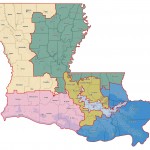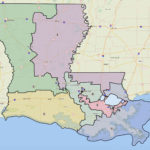Earlier today, JMC Analytics and Polling analyzed the July 1, 2017 Census estimates by parish for Louisiana and briefly discussed the political impacts of population shifts since the 2010 Census. This analysis will focus on a practical application of those revised population estimates: the impact on each of Louisiana’s six Congressional districts.
As with any redistricting discussion, some “political facts of life” are in order: redistricting itself is a very political process that nevertheless must operate within the confines of existing law, such as equal population constraints and the 1965 Voting Rights Act.
Given those “political facts of life”, the 2017 population estimates show that the average population of a Congressional district is approximately 781K. And in looking at the map, the two North Louisiana Congressional districts (District 4 represented by Republican Mike Johnson and District 5 represented by Republican Ralph Abraham) are noticeably below the desired population and must take in new territory. The other four districts (District 1 represented by Republican Steve Scalise, District 2 represented by Democrat Cedric Richmond, District 3 represented by Republican Clay Higgins, and District 6 represented by Republican Garret Graves) are all overpopulated and can lose some territory.
If, given the 2017 population estimates, one were drawing the lines with the goals of (1) equal populations, (2) smoothing out the lines, and (3) minimal disruptions to existing districts, the below approach is one way these goals could be simultaneously accomplished given the 2017 population estimates.
(1) The 3rd Congressional District is the easiest to adjust: it’s in the corner of the state, and is relatively compact. Plus, it is only slightly over the required population, so only minor adjustments need to be made, like (under this scenario) removing a handful of precincts in St Landry Parish as well as a handful of precincts in DeQuincy in Calcasieu Parish. These precincts would be given to the 4th Congressional district (represented by Republican Mike Johnson) to get his district closer to its desired population;
(2) Given that the 4th Congressional district is underpopulated, it can absorb territory from St Landry and Calcasieu Parishes from the 3rd Congressional District (represented by Clay Higgins). It would also be simplest for the district to absorb both southern St Landry Parish and Opelousas from the 5th Congressional District (represented by Ralph Abraham);
(3) The 5th Congressional District was already underpopulated, and given that it’s giving most of St Landry Parish to the 4th Congressional District, the Florida Parishes are a logical place to gain additional territory needed. After the 2011 redistricting, those parishes were appended to the 5th for the first time, although this district only contains portions of three parishes (East Feliciana, St Helena, and Tangipahoa). The district lines can therefore be smoothed out by picking up the rest of East Feliciana and St Helena from the 6th Congressional District. At the same time, additional territory in Tangipahoa Parish can be appended from the 1st District (Ponchatoula would be left in the 1st District, which is represented by Steve Scalise);
(4) At this point, the 1st, 2nd, and 6th Congressional districts are pretty close to the necessary district population, so only minor adjustments are required. However, from the standpoint of smoothing out the lines/representing similar constituencies, it is logical to move portions of St John and St Charles Parishes in the 6th Congressional District into the 2nd Congressional District, while giving Steve Scalise some precincts at the periphery of Kenner that are currently in the 2nd Congressional District. In and around Baton Rouge, the 6th district would make minor adjustments in Ascension and East Baton Rouge Parishes to acquire some territory from the 2nd Congressional District. Below is what the “finished product” would look like:
In conclusion, it must be emphasized that this is one of a theoretically infinite number of ways to draw the Congressional Districts. In an actual redistricting setting, equal population and voting rights laws are only the beginning, because input is provided by the Congressional delegation (as well as legislative stakeholders) into crafting such a plan.


